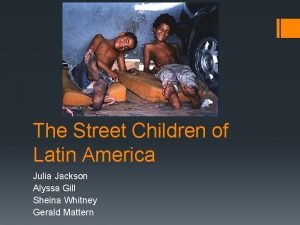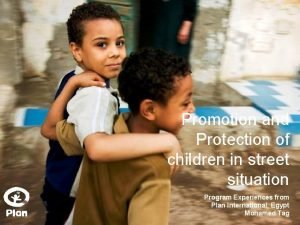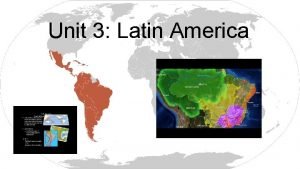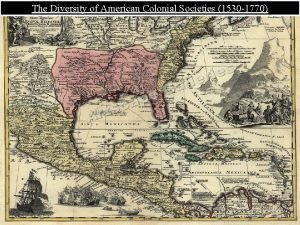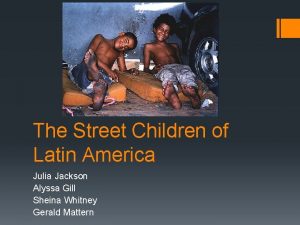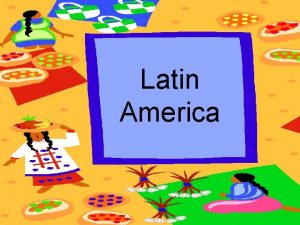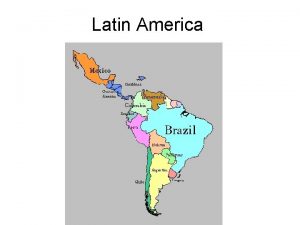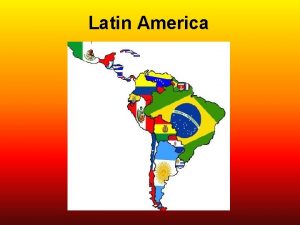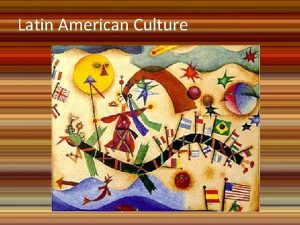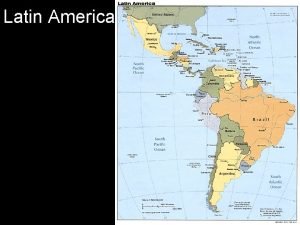The Street Children of Latin America Julia Jackson





















- Slides: 21

The Street Children of Latin America Julia Jackson Alyssa Gill Sheina Whitney Gerald Mattern

Who Are Street Children? § Children who live primarily on the streets of a major city § They are apart of the subcatergory: “thrown away children” § They are more likely to come from single parent homes, or from impoverished families § Usually in the densely populated areas of the developing nations in Latin America § There are two major types: home-based and street-based

Home-Based vs. Street-Based § Home-based are those who at some point have the opportunity to return home either after working all day in the streets or after a few days of making a little money § Street-based are the children who spend all their time on the streets and do not have homes or any contact to family. § Because some street children are home-based, it is sometimes difficult to determine just how many children are considered “street children”

A Few Characteristics § There is an estimated 40 million children living on the streets, or about 45% of the children in Latin America § Most come from shantytowns and the slums § Mostly males aged 10 -15, most girls are able to work in homes § They sleep under bridges, abandoned buildings, or in public parks § Most leave their families because they are abused by relatives, extreme poverty § Most become sexually active at a very early age, and engage in “survival sex” § Some girls are involve in prostitution § http: //www. ncbi. nlm. nih. gov/pmc/articles/PMC 1113205/table/T 2/

Main Causes § Most try to either support themselves, or supplement their families income § Most are forced on the streets because of economic necessities § Some families send their children to find work as street vendors, street workers, street entertainers. Those who aren’t with the family most steal and are beggars as well § Some go out with older siblings, then go into their own work § Inadequate government support to families § High birth rates leads to more children, which leads to more children ending up in poverty § Natural disasters, like hurricanes can displace families and children from one another, like in Haiti § The death of a parent § Mental and emotional abuse § Intentions of reaching America

Types of street children § There are three main subgroups of street youth in third world and developing countries. § The largest group is children who work in the streets part time. § The second group consists of children who run away usually for domestic abuse issues and survive by scavenging, begging and stealing § The third group consists of impoverished families who live in public areas

Outcomes: Abduction § Many children are abducted because they are orphans § Other children are convinced to be sold by their parents in hopes of providing better job opportunities or for quick profit

Outcomes: organ trade § Popular for homeless families to sell children and or organs for amounts ranging from tens to thousands of us dollars § Organs are sold all over the world through the black market

Outcome: Prostitution § Boys are exploited more often than young girls § Increased number of infected children with HIV § In sao paulo brazil, 4/5 of prison population is comprised of former street children § Red- illegal, blue- legal but not regulated, green- legal and regulated

Outcomes: Gangs § Gangs view children valuable resources § The majority of recruits are tricked into joining. Gangs offer protection, food, shelter, education, money ; essentials. It is also common for children to be drugged and threatened for services § Constantly decreasing age of recruitment

Solutions to the Problem of Street Children • There are numerous solutions to the issue of the increasing number of street children • The issue of street children has been traditionally tackled with four methods: • Institutionalization • Rehabilitation • Outreach • Prevention

Institutionalization (Government) § The institutionalization of street children was implemented with the goal of correcting behavior § Focused on correctional education instead of support and care § These programs were ineffective and expensive § Polarized street children by treating them as criminals

Rehabilitation (Community) § The most widespread community organizations are churches and local orphanages § These institutions deal with the issue of street children by providing housing, food, education, clothing and medical care § Community organizations focus on rehabilitation instead of institutionalization § There are issues with the process of rehabilitation as it is expensive and requires a long-term commitment § Children learn few skills and are not motivated to seek employment

Outreach (NGOs and Community Groups) § Emphasizes practical skills and employment § Deployment of “ecuadores de rua” (“street teachers”) who meet and educate children in their own communities § Some deem these programs a failure because they do not focus on preventing the creation of street children in the first place

Prevention (NGOs and Governments) § Focuses on economic problems and human rights issues § Utilizes self-help initiatives and educates families/children § Other initiatives include vocational training for parents and welfare programs for poor families § The main issue is that they are expensive

Examples of Nations with Street Children §Argentina Once a prosperous country Seen today as a developing country Economic globalization Wedge between classes Major Cities: -Buenos Aires -Córdoba -Rosario

Argentina: State of Children §Major Issues § Poverty § Violence in Education § Right to Education § Health § Native Children § Child Labor

Chile One of the most stable countries in Latin America Major Cities: Santiago Puente Alto

Children of Chile §Major Issues § Poverty § Healthy § Education § Child Labor § Child Abuse § Street Children

Discussion Questions • What do you think is the best solution method for helping street children (Institutionalization, Rehabilitation, Outreach or Prevention) ? • Why do you think the age of gang members being recruited continues being decreased? • Which other Latin American countries do you think would have a larger street child population?

Resources § Rizzini, Irene, and Mark Lusk. "Children in the Streets: Latin America's Lost Generation. " Street Children Resources. N. p. , n. d. Web. 23 Oct. 2013. <http: //www. streetchildrenresources. org/ wpcontent/uploads/2013/02/children-in-the-streets- latinamerica. pdf>. § http: //isw. sagepub. com/content/40/1/89. full. pdf+html § http: //www. lasco. ie/ § http: //www. casaalianza. org. uk/northsouth/Casa. Web. nsf/Street. Children/Street_Children_Facts? Open. Document § http: //www. ncbi. nlm. nih. gov/pmc/articles/PMC 1113205/ § http: //www. streetchildrenresources. org/wpcontent/uploads/2013/02/children-in-the-streets-latinamerica. pdf § http: //www. humanium. org/en/
 Street children in latin america
Street children in latin america Why called latin america
Why called latin america Rómeó és júlia júlia jellemzése
Rómeó és júlia júlia jellemzése Defy in a sentence
Defy in a sentence Children in street situation
Children in street situation Performance e body art
Performance e body art We can do a rap of the map of the us
We can do a rap of the map of the us America asia africa
America asia africa Whats an onomatopeia
Whats an onomatopeia Traje tipico de soloma
Traje tipico de soloma Rio grande river
Rio grande river Latin america physical map yucatan peninsula
Latin america physical map yucatan peninsula The bather juan cordero
The bather juan cordero Berlin conference scramble for africa
Berlin conference scramble for africa Amazon river
Amazon river South america literacy rate
South america literacy rate Lesson 1 latin america africa and the middle east
Lesson 1 latin america africa and the middle east Revolutions in europe and latin america
Revolutions in europe and latin america Chapter 25 the consolidation of latin america
Chapter 25 the consolidation of latin america Caste system in latin america
Caste system in latin america What is the encomienda system
What is the encomienda system How were nationalist revolts in latin america
How were nationalist revolts in latin america
